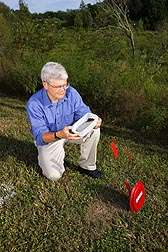New red imported fire ant enemies in place for combat

U.S. Department of Agriculture (USDA) scientists are releasing the fifth species of phorid fly to control fire ant populations. Red imported fire ants first arrived in the United States in the early 1930s and have been expanding along the southern portion of the country ever since, resulting in medical, agricultural and environmental impacts that cost the U.S. public billions of dollars each year.
Agricultural Research Service (ARS) entomologist Sanford Porter and his colleagues at the ARS Center for Medical, Agricultural and Veterinary Entomology (CMAVE) Imported Fire Ant and Household Insects Research Unit in Gainesville, Fla., have collected, bred and released phorid flies that help to control fire ant populations in the southern part of the United States. ARS is USDA's principal intramural scientific research agency.
Scientists at CMAVE and cooperators in several states conducted the fire ant biocontrol program to suppress the stinging insects in large areas. Since the program began in 1995, five species of phorid flies have been released to parasitize various sizes of fire ants, from large to very small. According to Porter, the relationship between phorid fly and fire ant is very specific: The introduced phorid fly species only attack imported fire ant species.
The fifth phorid fly species, Pseudacteon cultellatus, is currently being released at several sites in Florida to control tiny fire ant workers that belong to multiple-queen colonies. These colonies are particularly problematic because they usually house two to three times the number of worker ants.
Of the four phorid fly species previously released, only one has failed to establish itself and widely spread out. P. litoralis, released in 2004 and 2005, was only able to establish itself in Alabama. The others—P. tricuspis, P. curvatus, and P. obtusus—have expanded well beyond their release sites and are attacking fire ants across large areas. P. tricuspis and P. curvatus each cover over half of the U.S. fire ant range, and that is expected to increase to well over two-thirds of the range by the end of 2011, according to Porter.
More information: Read more about this research in the January 2011 issue of Agricultural Research magazine, available online.
Provided by USDA Agricultural Research Service
















